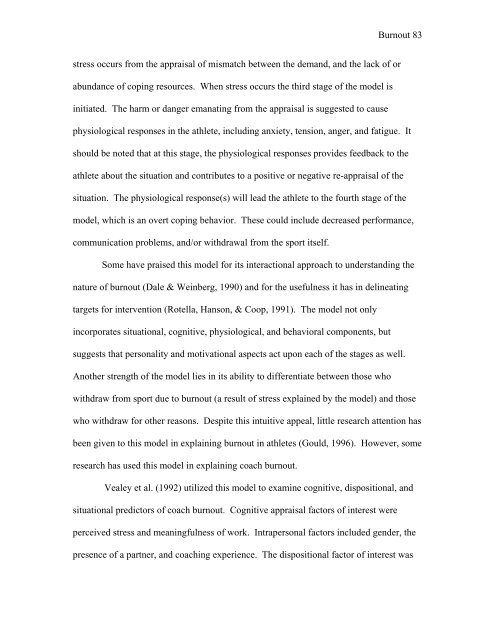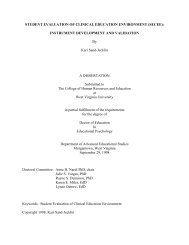Coach and Athlete Burnout - West Virginia University
Coach and Athlete Burnout - West Virginia University
Coach and Athlete Burnout - West Virginia University
You also want an ePaper? Increase the reach of your titles
YUMPU automatically turns print PDFs into web optimized ePapers that Google loves.
<strong>Burnout</strong> 83<br />
stress occurs from the appraisal of mismatch between the dem<strong>and</strong>, <strong>and</strong> the lack of or<br />
abundance of coping resources. When stress occurs the third stage of the model is<br />
initiated. The harm or danger emanating from the appraisal is suggested to cause<br />
physiological responses in the athlete, including anxiety, tension, anger, <strong>and</strong> fatigue. It<br />
should be noted that at this stage, the physiological responses provides feedback to the<br />
athlete about the situation <strong>and</strong> contributes to a positive or negative re-appraisal of the<br />
situation. The physiological response(s) will lead the athlete to the fourth stage of the<br />
model, which is an overt coping behavior. These could include decreased performance,<br />
communication problems, <strong>and</strong>/or withdrawal from the sport itself.<br />
Some have praised this model for its interactional approach to underst<strong>and</strong>ing the<br />
nature of burnout (Dale & Weinberg, 1990) <strong>and</strong> for the usefulness it has in delineating<br />
targets for intervention (Rotella, Hanson, & Coop, 1991). The model not only<br />
incorporates situational, cognitive, physiological, <strong>and</strong> behavioral components, but<br />
suggests that personality <strong>and</strong> motivational aspects act upon each of the stages as well.<br />
Another strength of the model lies in its ability to differentiate between those who<br />
withdraw from sport due to burnout (a result of stress explained by the model) <strong>and</strong> those<br />
who withdraw for other reasons. Despite this intuitive appeal, little research attention has<br />
been given to this model in explaining burnout in athletes (Gould, 1996). However, some<br />
research has used this model in explaining coach burnout.<br />
Vealey et al. (1992) utilized this model to examine cognitive, dispositional, <strong>and</strong><br />
situational predictors of coach burnout. Cognitive appraisal factors of interest were<br />
perceived stress <strong>and</strong> meaningfulness of work. Intrapersonal factors included gender, the<br />
presence of a partner, <strong>and</strong> coaching experience. The dispositional factor of interest was












